#nomen dubium
Text
There is no dinosaur named Troodon
Sunday 23/4/23

Alaskan Troodontid - Julio Lacerda @paleoart
A brief sorry for not writing for a while. Had a lot on my mind and also just struggled to get that jump-start on my creativity again. But after having a bit of nerd-out at a friend recently, I have a dinosaur related thing to talk about today.
For anyone knee-deep into dinosaur stuff, they'd know about the popular stereotyping around small meat eating dinosaurs. The likes of "Raptors" are often portrayed as problem solvers; coordinated, and clever. And although most modern birds have more developed brains than extinct non-bird dinosaurs, the exception of Troodon is often brought up.
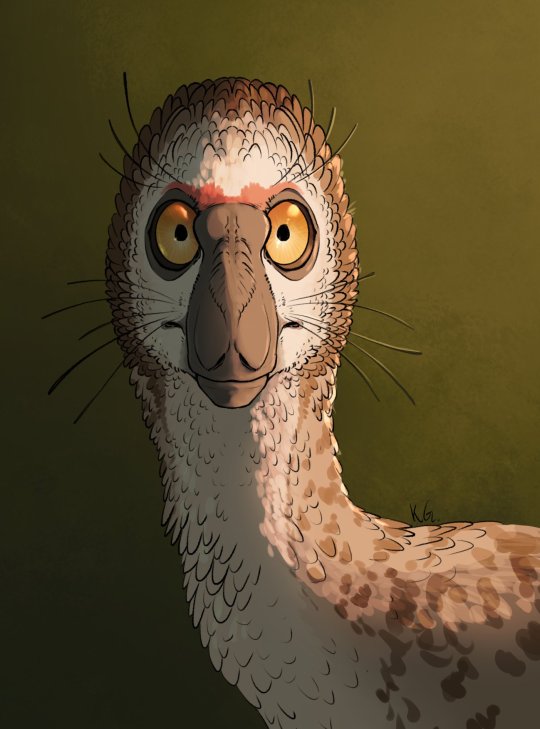
Troodon - @/the_meep_lord on Twitter
Troodon is a name that dino-nerds will bring up as a notable example of smart dinosaurs. It was one of the dinosaurs most closely related to birds, it had large eyes for its head, and in fact the largest brain to body size ratio of any non-avian dinosaur. But what many dino-nerds might struggle with, is that most palaeontologists believe that the genus Troodon is not valid.
Now when I first heard this information, my reaction was likely the same to yours reader. What do mean the genus isn't valid? Ask anyone what Troodon looks like, we have a very clear picture. How can we have full skeletons of a dinosaur that didn't exist? How come we have a significant clade of dinosaurs named after it (Troodontidae)? It is a dinosaur that even had unfortunate older stereotypes in its design (pictured below: the olive green smooth skinned Troodon that inspired the ugly Dinosauroid speculative biology thing).

llustration of Troodon - De Agostini Library (unable to find artist)
The issue, as I'll try to explain, was an unfortunate game of guesswork and generalisation across the Palaeontological community.
Discovery and Naming
In 1855, a single fossil teeth was found in Montana, USA. This was a particularly jagged tooth, and seemed to belong to some form of carnivorous or at least omnivorous reptile. It was named Troodon formosus meaning "wounding tooth, well formed". This tooth was originally classified as belonging to a lizard, so the genus Troodon was born.
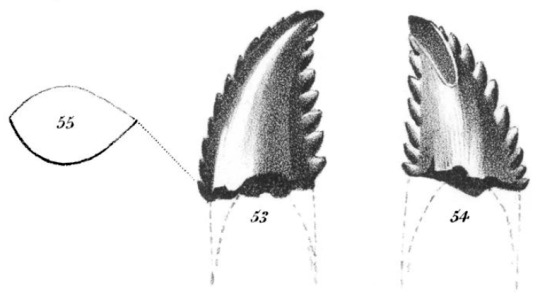
Troodon holotype drawing, 1860
In 1901, it was decided that Troodon's tooth belonged to a dinosaur, within the group Megalosauridae. But as I've discussed previously, Megalosaurus was a wastebasket taxon, and other experts wanted to place Troodon somewhere more definitive. In 1924, Troodon was classified as a relative of dome-headed dinosaurs such as Pachycephalosaurus and Stegoceras. And since Troodon pre-dated many dinosaurs in this group, the family was at the time referred to as Troodontidae.
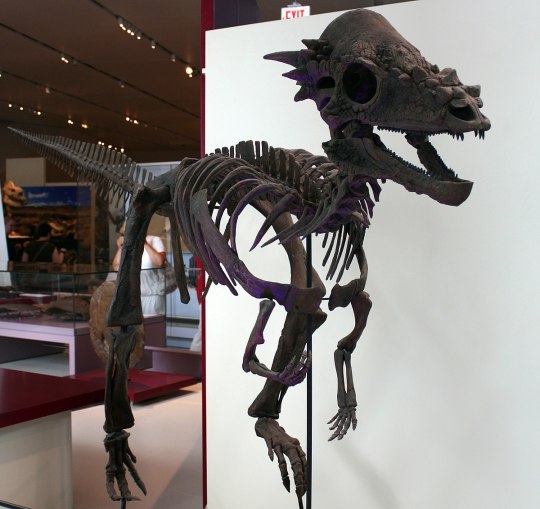
"Sandy", Pachycephalosaurus specimen at Royal Ontario Museum
Troodon as a Pachycephalosaur lasted until 1945, when Troodon was finally reclassified as carnivorous dinosaur, and the dome-headed dinosaurs were renamed under the title Pachycephalosauridae.
Other Troodontids
For a long time, the issue with Troodon was that because it's teeth were one of a kind, they did not know how the rest of it's body looked. The first dinosaur to be classified under Troodontidae that wasn't named just for teeth was a dinosaur called Stenonychosaurus (meaning 'narrow claw lizard").

Stenonychosaurus, Nix Illustration @alphynix
The original specimen of Stenonychosaurus did not have teeth, but it's close relative Saurornithoides did. And once both specimens had more complete specimens collected, they were classified under the group Saurornithoididae in the 1980s. But soon, scientists found similarities between the teeth of Saurornithoididae dinosaurs, and that of Troodon. The Principle of Priority states that earlier names for taxon are more valid taxonomically, so Saurornithoididae was considered synonymous with Troodontidae, and all specimens previously referred to as Stenonychosaurus were now called Troodon.

"Troodon" Specimen, Perot Museum, Texas
Most of the facts we now think of as Troodon were originally attributed to Stenonychosaurus, and many other North American Troodontids were considered as possible synonyms of Troodon, but this received some push back.
The idea that most of North America's Troodontids all belonging to one taxa was questioned. So, as had happened to other wastebasket taxon prior, Troodon was reanalysed.
In the late 2000s, a Troodontid called Pectinodon was separated from the Troodon genus and considered its own taxon. In the mid-late 2010s, some material originally classified under Stenonychosaurus, and then Troodon, was given its own genus, Latenivenatrix.

Latenivenatrix sculpture, @bookrat
Was "Troodon" really Troodon?
So the question of "What is a Troodontid?" had a very clear answer now. They were small to medium Theropod dinosaurs with narrow skulls, front facing eyes, larger braincases, and often restored with sickleclaws and feathers, similar to the Dromeosaurs. But the question came back to the Genus Troodon itself. We had sufficient material of many other Troodontids to tell what most of their body looked like, but the "holotype" of Troodon was still just one tooth.
In case you need a refresher on the terminology, a holotype is the first fossil a new species is named for. For another fossil to be named the same species, it needs to be identified as similar enough to the holotype. Holotypes are often fragmentary, it is common practice to fill in the full skeleton with details from similar relatives, but you still need enough details to identify who your relatives are.
The holotype of Troodon was so fragmentary, (again one bone), that it has been referred to as undiagnostic. Terminology lesson again, that means you CANNOT tell what it belongs to.

The fragmentary Holotype of the more recent Troodontid "Talos sampsoni", was almost complete in comparison to Troodon's. Credit: Scott Hartman
The Troodon tooth was *similar* enough to Stenonychosaurus that they were proposed to be close relatives, but there were differences enough for there to be initial scepticism at their synonymy. The original explanation proposed that the Troodon tooth came from an individual who was older, or in a different part of the mouth to teeth found from Stenonychosaurus, but this was never scientifically scrutinised, just proposed. The whole absorbing of Stenonychosaurus into Troodon was based on heresy that had never been scientifically tested.
So in 2017, almost universally, it was decided that Stenonychosaurus be separated from Troodon as its own valid dinosaur. Almost all material that had at that point been assigned to Troodon were reassigned to Stenonychosaurus or Latenivenatrix. And now the genus Troodon had a problem. If all known fossil material came down to a single, very undiagnostic tooth, then what WAS this dinosaur actually like?
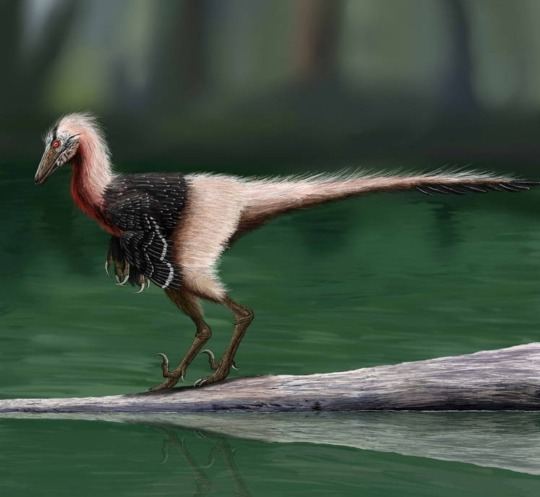
Stenonychosaurus - Anuperator (deviantart)
The current take is that there was no dinosaur known as Troodon in the technical sense. The tooth may not even belong to a Troodontid. But since Troodontidae has become an established group with established diagnostic traits, we still get to keep the name, for the group at least.
Troodontids Now
Troodontidae is still a very popular mainstream group of dinosaurs, but the names Stenonychosaurus, Saurornithoides, and Latenivenatrix are not as well known as Troodon. Many recent paleoart projects, particularly animations have depicted Troodon-like dinosaurs. But for scientific accuracy, they often decide to use the catch-all term "Troodontid", so audiences know what dinosaur we're talking about without being unscientific.
The YouTube Animation series "Dinosauria" features an episode on Arctic North American Dinosaurs. The main character is referred to as an Alaskan Troodon. This dinosaur has been originally proposed as a larger subspecies of Troodon described from larger teeth found in Alaska. As of writing, this Troodontid still does not an official description or scientific name.
youtube
In the 4th episode of the Apple TV+ series, Prehistoric Planet, we again see a dinosaur probably based on the Alaskan Troodon, this time just referred to as a "Troodontid".
youtube
In both pieces of media, the Troodontids engage in intelligent problem solving, but nothing on the level of what Jurassic Park would engage in. In Dinosauria, the Troodontid uses vocal mimicry. In Prehistoric Planet, it uses burning sticks to spread a wildfire. Both behaviours that different modern birds engage in, but may have been a stretch for what non-avian dinosaurs were capable of.
Thanks for Reading
If you are still a bit confused as to what this all meant, that's OK, it took me a while to get me head around it too. I encourage readers to do their own research and come to their own conclusion as to what this all means.
If you did feel my explanations helped you learn something new today, please reblog and spread the word. Of course add on your own commentary to the reblogs if you have insight that would better clarify the topic.
Thankyou for reading, and I'll hopefully have something else to post on here soon.
#blog#blogpost#palaeontology#dinosaurs#troodon#troodon formosus#stenonychosaurus#Latenivenatrix#Troodontidae#nomen dubium#theropod#Youtube#long post
80 notes
·
View notes
Text
Dinofact #117
Despite its popularity, Troodon is actually considered a wastebasket taxon and a dubious genus. One of the biggest factors to its dubious status is the fact that the holotype specimen is a single tooth.
Source: Wikipedia
#dinosaur#dinosaurs#paleontology#troodon#taxonomy#teeth#nomen dubium#fun facts#trivia#dinosaur trivia#dinosaur fun facts#6th#january#2022#january 6th#january 2022#january 6th 2022
11 notes
·
View notes
Text
I just learned that Quilmesaurus has an official JW toy
Really
Quilmesaurus?
QUILME-FUCKING-SAURUS?!?
A surprise, to be sure, but a welcome one
#jurassic world#jurassic park#Quilmesaurus#i bet 20 bucks none of you ever heard of it#it's kinda a nomen dubium so
0 notes
Text

Remember when people referred to Microceratus as "Microceratops", until it turned out that this name was already in use for an ichneumon wasp? Not only that but Microceratus is a nomen dubium, most material being reassigned to other genera. Anyway, uh, here's a wasp mimic ceratopsian because why not.
53 notes
·
View notes
Text
Agathaumas, the Lost Ceratopsian

I've talked about The Lost World (1925) a few times on this blog, partly due to it being the very first feature length film depicting dinosaurs, and partly due to how effective it is as a snapshot of dinosaurs during the early 1900s.
Anyone who has seen the film will note that there are actually two species of ceratopsians portrayed. The first is the more famous Triceratops, as seen in the photo above on the left.
The one on the right resembles a Triceratops, but looks a little...different. The nasal horn is a lot longer, the frill exhibiting more spikes, and it's hide more heavily armoured.
As you might've guessed, this isn't Triceratops. In fact...it's a dinosaur that may not have even existed.
Meet Agathaumas sylvestris ("marvelous forest-dweller"), one of the oldest described ceratopsians ever recorded. In fact, it was "discovered" before ceratopsians were even properly described.
youtube
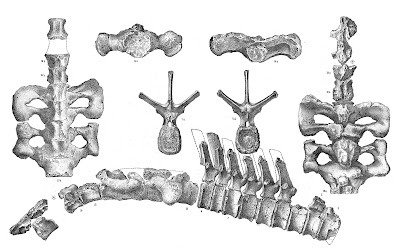
The original partial remains (AMNH 4000) were discovered in 1873 by Fielding Bradford Meek and Henry Martyn Bannister near Black Butte and Bitter Creek in Wyoming. They were eventually sent to the famous paleontologist Edward Drinker Cope who initially described it as a hadrosaur due to how fragmentary the fossils were. It wasn't until his rival Othniel Marsh described Triceratops did Cope recognize it as a ceratopsian in 1889.
And here's where things get...interesting.

As anybody interested in paleontological topics should know, Cope and Marsh were locked in a fierce rivalry called the Bone Wars, where the two competed to find the most specimens and describe the most species. In a series of publications ("The horned dinosauria of the Laramie" from the American Naturalist) Cope initially didn't recognize the name "ceratopsid" as a proper family name (believing that the namesake Ceratops wasn't related), and even argued for his own classification: Agathaumids. Furthermore, he grouped 4 other of his discoveries together in this family: Monoclonius, Dysganus, Manospondylus, and Claorhynchus.
Despite his efforts, Cope's gambit ultimately failed when in 1907, Agathaumas's validity was challenged by John Bell Hatcher. Due to the fragmentary nature of the fossils, it was later reclassified as a pseudonym for Monoclonius. This isn't anything unique for species described in the Bone Wars due to the rush to name new animals. And to rub salt in the wound, all of the members of the Agathaumids were considered to be nomen dubium (doubtful name) while Marsh's name Ceratopsids was chosen as the classification for the group (The Ceratopsia).

Armor for Agathaumas – Incertae Sedis (wordpress.com)
So where does that leave Agathaumas and the original remains? Nowadays, while the remains are still considered a holotype, it's widely considered to be a centrosaur. The painting by Charles R. Knight as seen from above came from the species Agathaumas sphenocerus, later reclassified as a species of Monoclonius, which is now believed to have been described from specimens of Styracosaurus and Centrosaurus. The reconstruction would later be used for the animal's depiction in the 1925 The Lost World. The genus as a whole is now typically regarded as synonym for Marsh's dinosaur, Triceratops (in a bit of irony).
So while now considered nomen dubium, Agathaumas is still rather interesting due to how a once notable dinosaur fell victim to science marching on, and how it got caught in the center of a notorious rivalry.
A big thanks to the I Know Dino podcast for covering this. Feel free to check them out cause they have a lot of good material for dinosaur enthusiasts. Also feel free to check out any of the articles cited in the post if you want some additional reading, and this great video by E.D.G.E from YouTube.
Agathaumas | The Horned Dragon That Never Was - YouTube
#agathaumas#ceratopsian#ceratopsid#edward drinker cope#othniel march#bone wars#charles r. knight#dinosaur#dinosaurs#paleontology#the lost world 1925#styracosaurus#centrosaurus#triceratops
43 notes
·
View notes
Text


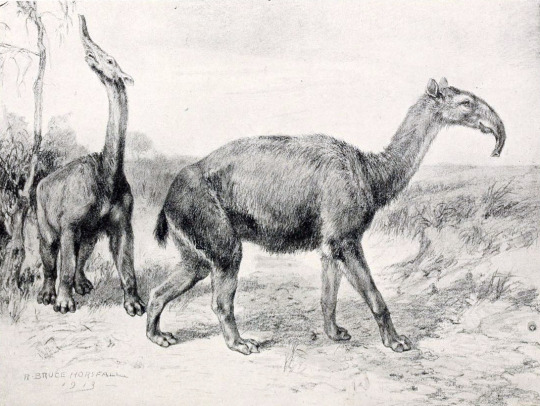
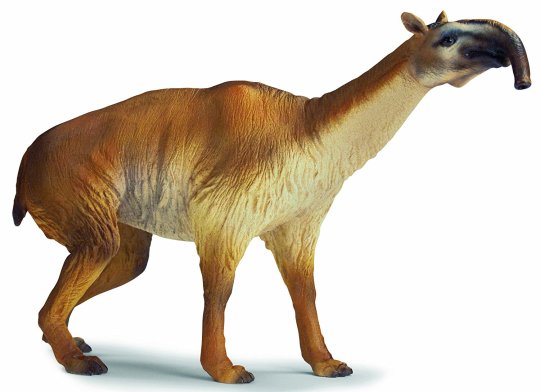


Macrauchenia
(temporal range: 7-0.01 mio. years ago)
[text from the Wikipedia article, see also link above]
Macrauchenia ("long llama", based on the now-invalid llama genus, Auchenia, from Greek "big neck") was a large, long-necked and long-limbed, three-toed native South American ungulate in the order Litopterna.[1] The genus gives its name to its family, the Macraucheniidae or "robust litopterns". Like other litopterns, it is most closely related to the odd-toed ungulates (Perissodactyla), from which litopterns diverged approximately 66 million years ago. The oldest fossils in the genus date to the late Miocene, around seven million years ago, and M. patachonica disappears from the fossil record during the late Pleistocene, around 20,000-10,000 years ago. M. patachonica is one of the last and best known member of the family and is known primarily from the Luján Formation in Argentina, but is known from localities across southern South America. Another genus of macraucheniid Xenorhinotherium was present in northeast Brazil and Venezuela during the Late Pleistocene. The type specimen was discovered by Charles Darwin during the voyage of the Beagle. In life, Macrauchenia may have resembled a humpless camel, though the two taxa are not closely related.[2] It fed on plants in a variety of environments across what is now South America. Among the species described, M. patachonica and M. ullomensis are considered valid; M. boliviensis is considered a nomen dubium; and M. antiqua (or M. antiquus) has been moved to the genus Promacrauchenia.
6 notes
·
View notes
Text
Problematyczna zoologia z Afryki
« dnia: Kwietnia 06, 2022, 11:21 »
Świat dzikich zwierząt stał się tematem dla literatury popularnonaukowej takich autorów jak Bernard Heuvelmans czy współcześnie Lorenzo Rossi. Więc w istocie, Afryka jest domem dla populacji zwierząt stanowiących formy enigmatic taxa lub nomen dubium. Nauka dysponuje wiedzą o faunie tego regionu świata, lecz wiele eksponatów oraz relacji podróżników jest wciąż odłożonych na półkę opatrzoną tabliczką-zagadki przyrodnicze. Jest to świat naturalny, w którym żyją formy zwierzęce dotychczas nieopisane przez zoologię. Warto więc zdobyć się na odwagę i odkryć zasoby stworzeń nieznanych oficjalnej nauce.
Link do artykułu:
https://zoologi.fria.ifokus.se/discussion/1537640/odkrycia-dzikich-zwierzat-na-ladzie-afrykanskim
0 notes
Note
Unsolicited infodump about Allosaurus GO
Okay so currently there are three different species of Allosaurus - A. fragilis, A. jimmadseni, and A. europaeus. There used to be a bunch more species during the Bone Wars era but after closer examination there were found to only be three. A. fragilis is the most common found and the best known because of it, and also the type species. Big Al is the most famous specimen of Allosaurus and was previously thought to be A. fragilis but it's actually A. jimmadseni! And the differences between those two species are most in bits of the skull, like the shape of the lacrimal crests and stuff. And the lacrimal crests are those crests over the eye that Allosaurus is best known for. They're not exclusive to Allosaurus, not at all, but it's the genus that is most famous for them. A. europaeus is the least well known of the three species and last I remember, might be a nomen dubium. Which just means it's a dubious name. I've spent too much time reading actual professional shit OKAY BYE NOW.
OKAY WOAH THATS COOL
i used to have a small dinosaur phase a while ago but it faded fast and i don’t remember anything 😭
your dedication is honored, comrade
24 notes
·
View notes
Note
Is Allosaurus a nomen protectum?
No. I assume this is about the possibility that Allosaurus is synonymous with “Antrodemus”, which mostly goes unused in recent literature because it is generally considered undiagnostic and thus a nomen dubium. Antrodemus does not fulfill the requirements to be declared a nomen oblitum anyway, as it has been used as a valid taxon after 1899 (by Gilmore, 1920, for example). However, if Antrodemus turns out to be demonstrably synonymous with Allosaurus, a case for suppressing it can be brought to the ICZN for consideration.
2 notes
·
View notes
Text
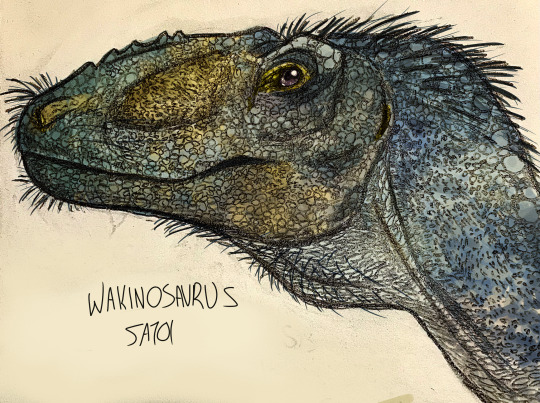
Another friend!
Colors based on a Merlin Falcon
Wakinosaurus: Wakino Lizard.
Satoi: named after the person who discovered it, Masahiro Sato
-Wakinosaurus is a member of the Charcharodontisauridae family from Early Cretaceous Japan.
-Holotype contained a single tooth with a damaged crown and serrations on both sides.
-it was originally described as a Megalosaurid but is now described as a Nomen Dubium (unknown whether it’s a valid species), and could possibly be a Neotherapod. It’s argued the tooth could have come from Prodeinodon, or from a different basil allosaurid like Acrocanthosaurus
Also I know nothing(besides a lot of types) of avian dinosaurs aka birds and the way I’m choosing coloring is just via a random bird generator ✌🏼
#I just love drawing controversial Dinos and noben dubiums apparently#in truth I’m just going clade by clade this wasn’t intentional I swear#also did this during AP Spanish because I am just that sexy#dinosaur#dinosaur art#therapod#wakinasaurus#wakinasaurus satoi#paleo#paleontology#paleontologist#charcharodontisauridae#charcharodontisaurid#allosaurini#allosauridae#allosaurid#paleoart#angstybreadstyx art
7 notes
·
View notes
Text
Wednesday 13/10/21 - Dinosaurs of the World Part 4; Madagascar and India

Majungasaurus grabs the tail of a Madagascan crocodilian, Mahajungasuchus; Sergey Krasovskiy
When you think of our current geography, it makes sense to think of Madagascar as part of Africa's greater biosphere; a lot of biota found there now have relatives on the African mainland. The same for India, even more so because the Indian continental plate has made landfall on the Asian Mainland. But in the Mesozoic Period, these two landmasses were more associated with the southern continents of Australia, Antarctica, and South America. India wasn't even a part of Asia until after the dinosaurs went extinct.
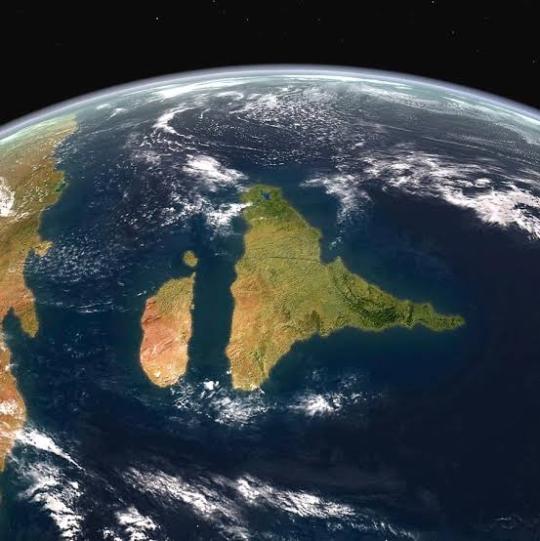
Late Cretaceous Madagascar and India, Walter Myers
During the age of reptiles, India and Madagascar were best buddies, and biogeographically, palaeontologists unite these two as their own distinct region. In terms of dinosaur diversity, the two regions share a lot in common with South America. Titanosaur Sauropods and Abelisaur Theropods are king in these regions. So when I started to construct a list of dinosaur highlights, I found it difficult to make a list of dinosaurs that weren't all Sauropods and Abelisaurs. So compared to my Africa, and Asia episodes, this list will be a bit shorter, but rest assured, there is a lot to discover about dinosaurs from Madagascar and India.
Isisaurus colberti

Isisaurus, Dmitry Bogdanov
Isisaurus was a large sauropod from Late Cretaceous India. It was a member of the Titanosaur clade, the largest and longest, and heaviest of all dinosaurs. Isisaurus colberti was originally called Titanosaurus colberti, united with the Indian dinosaur that this clade is named after, but closer inspection of its fossils led palaeontologists to classify Isisaurus in its own genus. Titanosaurus itself is currently a nomen dubium: a species that may not be real because remains are too fragmentary to be sure.
The most distinguishing feature of Isisaurus is its tall neck spines, giving it a very unique appearance for a Titanosaur, but it's not really known why they had them. Isisaurus coprolites (fossil poo) have had parts of pathogenic (diseasing) fungus found in them, giving paleobotanists a unique insight into the plant life of its habitat. Isisaurus is also unique in its name. It does not in fact call reference to the Egyptian God Isis, but it is fact named for the ISI (Indian Statistical Institution), making the only dinosaur I personally know to be named after an acronym.
Barapasaurus tagorei
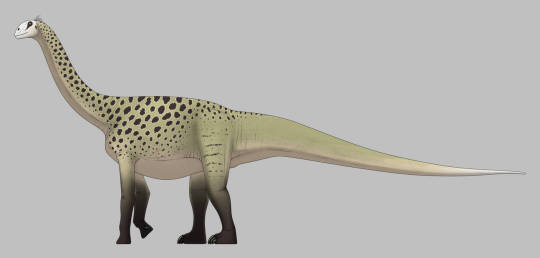
Barapasaurus, SpinoInWonderland (deviantart)
Barapasaurus was an Early Jurassic Sauropod from central India. It was very early for a Sauropod, evolutionarily, but quite large for its time, 5.5 m tall and 14 m long. It's skeleton reveals a lot of traits basal to the true sauropod group, but was primitive in others, particularly its feet. Barapasaurus was the first dinosaur skeleton to be mounted in an Indian Museum, in 1977. It's name is also part Indian (Bengali), Bara meaning "Large", and Pa meaning "Leg" and of course the Greek Saurus to end it out. The large leg bone in question being the first bone of the animal found.
Dravidosaurus blandfordi

Dravidosaurus, Pavel Riha
Dravidosaurus was (potentially) a late surviving Stegosaur found in Late Cretaceous India. So far in these lists, I've tried to avoid highlighting Nomen Dubium, but I wanted a bit of variety in my Indian Dinosaurs, so this is an exception. Dravidosaurus is named for the Dravidanadu region of South India where it was found. Studies of the specimen in the 1990s hypothesised it was a plesiosaur, a type of marine reptiles related to turtles. But studies in the 2010s decided that among the remains found are a Stegosaur back plate and tail spike, but there's still too little material to be sure of anything. If it was indeed a Stegosaur, it was one of the smallest, 3 metres long and maybe half a metre tall.
Rahonavis ostromi

Rahonavis, Julio Lacerda (@paleoart on tumblr)
Rahonavis was a small theropod dinosaur from Late Cretaceous Madagascar. It's exact classification has been subject to much debate since it was first described, as it lies right on the boundary between non-avian dinosaurs and the earliest true birds. Depending on who you ask, Rahonavis is either a basal Avialan like Archaeopteryx, or an extremely derived dromeosaur like Dakotaraptor or Microraptor. Given the shape of its arms, and the evidence of flight feathers, Rahonavis was likely capable of flight, but wasn't as good in the air as modern birds. It was the size of a typical modern bird too, about 70 cm long. It's name consists of the Malagasy Rahona, meaning "Cloud/Menacing" and the Latin Avis, meaning "Bird".
Majungasaurus crenatissimus

Majungasaurus, Moonmelo (deviantart)
Majungasaurus was a medium sized Abelisaur theropod from Madagascar. It was from the very end of the Cretaceous period, one of the last dinosaurs. Majungasaurus was about 3 m tall and 8 m long. It had one of the most complete skull fossils of its family, with a blunt snout, sturdy, but wrinkled face structure, and its signature cone shaped horn right between its eyes. The horn was not built for combat and would've likely been a display structure. Its short but robust jaw allowed Majungasaurus and other Abelisaurs to bite down and twist more effectively than other theropods, and may have been specialised for hunting the many Sauropod species that inhabited Madagascar in its time. Majungasaurus is named for the Mahajunga province of North Madagascar.
The unique horn shape may be the most visual diagnostic feature of Majungasaurus, but many actually know the dinosaur for being the only non-avian dinosaur to have evidence of cannibalism. Signature bite marks found in Majungasaurus prey has also been found in other adult and juvenile Majungasaurus specimens. Palaeontologists are unsure if this is evidence of Majungasaurus actively hunting other members of its species, or if they simply scavenged on the dead.
Thanks for Reading
I apologise for making this article a bit shorter than the last couple has been. I've been trying to include some variety in dinosaur clades in these regional highlights, so rather than discuss mostly Abelisaurs and Titanosaurs, I picked one of each and then a few more notable species I could find. There really are a lot of interesting species from both India and Madagascar, so I recommend looking up info on the other interesting dinosaurs from the regions.
Next blogpost I'm thinking Europe, and there's quite a few interesting species I can think of already without consulting the entire list of species. My intention is to do North America last, since most of the species people know are from there and I want my readers to savour what the rest of the world has to offer first. As usual, links to previous and future articles below, and will be edited once I have written more.
<< Part 3: Africa || Part 5: Europe >>
#blog#blogpost#palaeontology#dinosaurs#indian dinosaurs#madagascan dinosaurs#isisaurus#barapasaurus#dravidosaurus#rahonavis#majungasaurus
37 notes
·
View notes
Text
Dinofact #22
Although they are often confused, Giganotosaurus and Gigantosaurus are two distinct and very different genera. The more well-known of the two, Giganotosaurus, is a large theropod, one of the largest known carnivores. Gigantosaurus, however, is a dubious genus of sauropod, which consists of several seperately discovered fossils, and which is considered a nomen dubium.
Source: wikipedia [1], [2]
#dinosaurs#dinosaur#paleontology#giganotosaurus#gigantosaurus#theropods#theropoda#sauropods#sauropodomorpha#sauropoda#trivia#fun facts#dinosaur fun facts#dinosaur trivia#15th#september#2022#september 15th#september 2022#september 15th 2022
34 notes
·
View notes
Photo

Is a genus of ornithopod dinosaur that existed roughly halfway between the first of the swift bipedal hypsilophodontids of the mid-Jurassic and the duck-billed dinosaurs of the late Cretaceous. While many species have been classified in the genus Iguanodon, dating from the late Jurassic Period to the early Cretaceous Period of Asia, Europe, and North America, taxonomic revision in the early 21st century has defined Iguanodon to be based on one well-substantiated species: I. bernissartensis, which lived from the late Barremian to the earliest Aptian ages (Early Cretaceous) in Belgium, Spain, Germany, England, Portugal and possibly elsewhere in Europe, between about 126 and 122 million years ago. Iguanodon were large, bulky herbivores. Distinctive features include large thumb spikes, which were possibly used for defense against predators, combined with long prehensile fifth fingers able to forage for food. The genus was named in 1825 by English geologist Gideon Mantell but discovered by William Harding Bensted, based on fossil specimens found in England and was given the species name I. anglicus. Iguanodon was the second type of dinosaur formally named based on fossil specimens, after Megalosaurus. Together with Megalosaurus and Hylaeosaurus, it was one of the three genera originally used to define Dinosauria. The genus Iguanodon belongs to the larger group Iguanodontia, along with the duck-billed hadrosaurs. The taxonomy of this genus continues to be a topic of study as new species are named or long-standing ones reassigned to other genera. In 1878 new, far more complete remains of Iguanodon were discovered in Belgium and studied by Louis Dollo. These were given the new species I. bernissartensis. In the early 21st century it became understood that the remains referred to Iguanodon in England belonged to four different species (including I. bernissartensis) that were not closely related to each other, which were subsequently split off into Mantellisaurus, Barilium and Hypselospinus. It was also found that the originally described type species of Iguanodon, I. anglicus was a nomen dubium, and not valid. Thus the name "Iguanodon" became fixed around the well known species based primarily on the Belgian specimens. Scientific understanding of Iguanodon has evolved over time as new information has been obtained from fossils. The numerous specimens of this genus, including nearly complete skeletons from two well-known bone beds, have allowed researchers to make informed hypotheses regarding many aspects of the living animal, including feeding, movement, and social behaviour. As one of the first scientifically well-known dinosaurs, Iguanodon has occupied a small but notable place in the public's perception of dinosaurs, its artistic representation changing significantly in response to new interpretations of its remains.
Herbivore
Iguanodon (c) Carnivores: Dinosaur Hunter
Art (c) reneg661
2 notes
·
View notes
Text
Polyonax mortuarius

By José Carlos Cortés
Etymology: Master over Many
First Described By: Cope, 1874
Classification: Dinosauromorpha, Dinosauriformes, Dracohors, Dinosauria, Ornithischia, Genasauria, Neornithischia, Cerapoda, Marginocephalia, Ceratopsia, Neoceratopsia, Coronosauria, Ceratopsoidea, Ceratopsidae
Status: Extinct
Time and Place: Around 66 million years ago, in the Maastrichtian of the Late Cretaceous


Polyonax is known from the Lower Denver Formation in Colorado

Physical Description: Polyonax was some sort of Ceratopsian, a quadrupedal herbivorous dinosaur with a frill over its neck and a stout beak in the front of its mouth. It would have had a shorter tail and somewhat squat legs. Beyond that, we know very little about it. We have the vertebrae and some of the horn cones, which show us that it was a subadult that had horns on its face of some sort. It might have resembled Triceratops and its kind, but even that is a question. It would have been mainly scaly, though some tail quills is not out of the question.
Diet: As a Ceratopsian, Polyonax would have primarily fed upon mid-level and lower-lying plants, as well as possibly supplementing its diet with meat and other sources of food when necessary.
Behavior: It is difficult to say what the behavior of Polyonax was without more fossil evidence. Fights between members of the species using the horns would have probably occurred, for mates and territory and food. They also would have probably defended themselves from predators using the horns. The frills would have been distinctly patterned and brightly colored, for communication between members of the species. It probably would have been a very active animal, living in social groups and taking care of its young. But even then, all of these are guesses.
Ecosystem: The Denver Formation was a flooded river pain, with a wide variety of braided rivers stemming down to the nearby Inland Sea. This was an area filled with marshes and thick water plants, with sandy and muddy shores that would have been hard to get through. It was also extremely heavy on trees, and in general a very lush sub-tropical forest environment. There were probably regular volcanic explosions as well. The plant life was diverse - with ferns and magnolias, ficuses and clubmosses, palms and more flowering plants - pointing to the sub-tropical marsh environment that Polyonax lives in. There were a wide variety of turtles living in this lush place, as well as mammals. It was also cozy little dinosaur community, with hadrosaurs like Edmontosaurus, the dome-headed Pachycephalosaurus, the ostrich-mimic Ornithomimus, and the large predator Tyrannosaurus that would have been the main danger for Polyonax. In terms of other Ceratopsians, there was Triceratops - which may or may not be the same thing as Polyonax in the end.
Other: Because Polyonax was described such a long time ago and from such poor remains, it is a nomen dubium - a dubious genus of dinosaur. The material isn’t good enough to say it’s definitely the same as another dinosaur, but it also isn’t good enough to say it is definitely some sort of unique dinosaur. As such, it can’t be eliminated as a genus, nor really talked about in anything resembling detail. So that’s annoying! Yay science.
~ By Meig Dickson
Sources under the Cut
Carpenter, K. and Young, D.B. 2002. Late Cretaceous dinosaurs from the Denver Basin, Colorado. Rocky Mountain Geology, vol. 37, p. 237-254.
Cope, E.D. (1874). Report on the stratigraphy and Pliocene vertebrate paleontology of northern Colorado. Bulletin of the U.S. Geological and Geographical Survey of the Territories. 9:9-28.
Dodson, P. (1996). The Horned Dinosaurs. Princeton University Press:Princeton, New Jersey.
Dodson, P., Forster, C.A., and Sampson, S.D. (2004). Ceratopsidae. In: Weishampel, D.B., Dodson, P., and Osmólska, H. (eds.). The Dinosauria (second edition). University of California Press:Berkeley, 494-513.
Eberle, J.J. 2003. Puercan mammalian systematics and biostratigraphy in the Denver Formation, Denver Basin, Colorado. Rocky Mountain Geology, vol. 38, no. 1. p. 143-169.
Emmons, S.F., Cross, W. and Eldridge, G.H. 1896. Geology of the Denver Basin in Colorado. U.S. Geological Survey, Monograph 27, p. 160.
Glut, D.F. (1997). "Polyonax". Dinosaurs: The Encyclopedia. McFarland & Company. pp. 723–724.
Hatcher, J.B. (1902). The genus and species of the Trachodontidae (Hadrosauridae, Claosauridae) Marsh. Annals of the Carnegie Museum 14(1):377-386.
Hatcher, J.B., Marsh, O.C., and Lull, R.S. (1907). The Ceratopsia. Government Printing Office:Washington, D.C., 300 pp.
Hutchison, J.H. and Holroyd, P.A. 2003. Late Cretaceous and early Paleocene turtles of the Denver Basin, Colorado. Rocky Mountain Geology, vol. 38, no. 1, p. 121-142.
Johnson, K.R., Reynolds, M.L., Werth, K.W., and Thomasson, J.R. 2003. Overview of the Late Cretaceous, early Paleocene, and early Eocene megafloras of the Denver Basin, Colorado. Rocky Mountain Geology, vol. 38, no. 1, p. 101-120.
Kauffman, E.G., Upchurch, G.R. Jr., and Nichols, D.J., 2005. The Cretaceous-Tertiary boundary at South Table Mountain near Golden, Colorado. In: Extinction Events in Earth History, Lecture Notes in Earth Sciences, vol. 30, p. 365-392.
Kile D.E., 2004. Zeolites and associated minerals from the Table Mountains near Golden, Jefferson County, Colorado. Rocks and Minerals, vol. 79, no. 4, p. 218-238.
Lambert, D., and the Diagram Group. (1990). The Dinosaur Data Book. Facts on File:Oxford, England, 320 p.
Raynolds, R.G. 2002. Upper Cretaceous and Tertiary stratigraphy of the Denver Basin, Colorado. Rocky Mountain Geology, vol. 37, no. 2, p. 111-134.
Raynolds, R.G. and Johnson, K.R. 2003. Synopsis of the stratigraphy and paleontology of the uppermost Cretaceous and lower Tertiary strata in the Denver Basin, Colorado. Rocky Mountain Geology, vol. 38, no. 1, p. 171-181.
Romer, A.S. (1956). Osteology of the Reptiles. University of Chicago Press:Chicago, 1-772.
Tweto, O. 1979. Geologic map of Colorado. U.S. Geological Survey, Map G77115.
Van Horn, R. 1957. Bedrock geology of the Golden Quadrangle, Colorado. U.S. Geological Survey, Map GQ-103.
Weishampel, David B.; Dodson, Peter; and Osmólska, Halszka (eds.): The Dinosauria, 2nd, Berkeley: University of California Press. 861 pp.
Weishampel, David B; et al. (2004). "Dinosaur distribution (Late Cretaceous, North America)." In: Weishampel, David B.; Dodson, Peter; and Osmólska, Halszka (eds.): The Dinosauria, 2nd, Berkeley: University of California Press. Pp. 574-588.
#Polyonax mortuarius#Polyonax#Ceratopsian#Dinosaur#Palaeoblr#Factfile#Prehistoric Life#Paleontology#Prehistory#Mesozoic Monday#Herbivore#Cretaceous#North America#dinosaurs#biology#a dinosaur a day#a-dinosaur-a-day#dinosaur of the day#dinosaur-of-the-day#science#nature
83 notes
·
View notes
Text

(( ENJOY A MASSIVE POST ABOUT MERFOLK TAXONOMY, because biology has long been my BIGGEST special interest ( yes I’m including paleontology under this, I know it’s more considered an earth science and part of geology, shush ).
Merfolk as a whole are a part of an ancient group of animals that diverged from basal amniotes around the same time amniotes themselves came about, 312 mya (million years ago). I say about, because I haven’t fully decided where exactly to put them in this case, whether they’re fully counted as amniotes or no, and I still need to do a large amount of research into this.
I classify this split as happening there, as opposed to somewhere else, because merfolk are obviously tetrapods, and have some adaptations for full land living that amniotes have, though the merfolk themselves are fully adapted for a watery niche. Their eggs certainly were carried internally for a long time, so there’s probably some convergent evolution to how mammalian live birth happened, hence all the more reason to put them under amniotes, but they’re definitely not synapsids and thus definitely not mammals.
These early ancestors also retained their gills and ability to breathe water. They do have lungs too, and conceptually they filled a very fluid niche, where they had to be able to rapidly switch from aquatic life to terrestrial life, with most being oppurtunists who used this wide variability to be able to get a wider variety of food and resources that other animals couldn’t.
I will say these early ancestors mostly resembled newts/salamanders or small lizards, and somewhere along the line they independently evolved scales, both for providing armor and for retaining water when they were on land, along with all the other reasons to evolve scales.
( Ideally, I’d say they never evolved hair, but considering that I can’t fully redesign Miranda for this blog for fear of inability to use my icons and basically making her fully an OC, she has to keep the hair on her head. Her eyebrows are a maybe, since I joke aplenty about them just being markings or her drawing them on. Landfolk get weird when they see her without any eyebrows, so she has to appear to have them! )
They also generally retained the same amount of digits as other tetrapods, so that’s how Miranda has five fingers still, though merfolk lost one of the toes on their feet, bringing that total down to four.
And yes, all of this does mean that merfolk have plenty of ancestors in deep time that probably fossilized and could be found by even human scientists, but they’re probably thought of in this world as an offshoot of tetrapods that has no extant relatives, with what fossils remain being sparse or incomplete, or even caught in nomen dubium hell. Certainly they weren’t featured in this world’s Jurassic Park, that’s for sure, and if they are represented it’d be in something like ARK.
This also does mean that there are plenty of ancestors that fell into more unique or odd niches, with stranger body plans or something much more different from the rest. 312 mya is a long time, after all! Lots of time for there to be more experimental species, though they didn’t pan out in the long run.
So, with merfolk themselves, I generally have the idea of them as coming from a branch of that tree that hung around the ocean’s edge, sticking closer to the shoreline than the mer alive today, though they were oddly social for a tiny, lizard-like species, probably already communicating through small squeaks and chirps. Lizardy kinda sounds. They spend a good amount of their time on rocky shores and cliffs, so they’re good at climbing over and up them. Likely already had something akin to their fins on the sides of their face, used for communication and display, along with pushing additional water over their gills, or maybe even the fins being used in addition to the gills to extract extra oxygen from the water is basal to merfolk, but only the abyssals really retained most of that feature.
As token as it sounds, I think the K/T extinction event was probably what pushed them to evolve into the branch that became merfolk. The death of much larger marine creatures opened up the ability to go more fully ocean-bound, and to take over a role akin to marine reptiles in the past and the marine mammals that were also evolving at that time, but with the addition of having gills to not have to surface for oxygen.
Their evolution from that point probably was a bit like primates - lots of trying out different shapes and styles, more of that basal form than true merfolk, except their roles being out competeted or otherwise led to extinction, until you get the “true” merfolk - which would occur with a focus on social behavior and language, along with tool use, as was the bonus to being a tetrapod that went back into the ocean but never lost their hands.
This is where we get to the merfolk family tree. I’d say probably the first mer was mid-size, generally had all of the traits of the merfolk you see today, very general, but very adaptive.
The abyssal (royal) merfolk were probably the first to branch off. Their tails resemble mosasaurs’ and early icthyosaurs’ a lot, having a much larger lower lobe of their tail where the bone is, and the upper lobe, being all fleshy, isn’t too pronounced. They went down into the deep sea, branching off early from the rest of the merfolk, and thus were generally super isolated from the rest, which you can see today in how the Merkingdom itself generally is conducted.
There are plenty of other species of merfolk, however, and the abyssals (and Miranda) are not representative of the entire group. There’s a lot of different takes on the same body plan, with different niches and different adaptations and different types of behavior associated with each. They’re all super vocal and adapted to be able to hear well, so that’s also basal to the group, but that also means when they all started forming their own societies and cultures and general settlements, it’s even weirder than how humans do it.
Effectively, merfolk are a lot like the homonid family tree, and for that reason they also generally take after the concept of the “braided stream” more than just the tree of life. It’s also why I can feel more confident saying they’re seperate species and not subspecies, despite being able to reproduce and make viable offspring - and anyway species as a whole are fake and weird. There’s a lot of hybridization going on, with some populations getting some genes from others that benefit them and get genetic and physical variation. In more nomadic merfolk, there’s a lot of their genes spread around in other species and a lot of genetic variation in them, because they roam and run into different species - meanwhile, the abyssals are much more genetically restricted, since the abyss is a generally isolated place that isn’t easy to access unless you’re made for it.
I’m pretty bad at clarifying when I’m talking about abyssal mer vs all merfolk, since there’s a huge amount of difference between the two. Abyssals are probably the merfolk with the most bioluminenscence - while some species probably do have a little or even a lot, it’s not as much of a need as with the abyssals. The abyssals also might have gone through deep-sea gigantism? They’re pretty big by merfolk standards. And yes, that is taking into account how tiny Miranda herself is - since she’s kind of an exception to the rule, being that she didn’t really grow right and her bones didn’t get the chance to form correctly, leaving her as a rather unhealthy-looking runt of an abyssal. I’m generally thinking mer grow throughout their entire lives, as something that’s also basal to the group, they just slow down after a point - so if you got proper care for Miranda’s health issues she might be able to fix some of that problems, and mer medicine is waaaaay more sophisticated and generally ahead than current human medicine, so if it was treated she might be able to come up to a respectable height and avoid some of the isssues of that kind of deformity that’ll occur later in life.
I do believe as a whole, merfolk are rather large. Some are more sleek than others, but especially with abyssal mer, they put on fat and muscle really easily. They’re a lot like large crocodiles in that respect. Again, Miranda is an exception to this rule, as she’s really not healthy - but overall, merfolk are DENSE. Abyssals tend to have tough armor, dense bones, put on muscle and fat easily, and generally should be MUCH heavier than a human of the same size. Not to mention their tails, as unless a mer is in the really late stages of starvation, they keep most of the muscle on their tails. It’s how they swim and get around, so losing that muscle is basically a death sentence to merfolk.
There’s also variation in diet, dentition, and what they can digest. I will say all merfolk generally can handle meat - some of them are more adapted towards eating coral or plant matter or filter-feeding, but generally they can all digest and handle it and won’t turn it down if they do get it. The abyssals do tend towards being carnivores and most of their diet should be meat, but they can handle other biological material as well. They’re equal parts predator and scavenger - their jaw strength is a lot like a hyena’s or a T. rex’s (at least, in the theory of them being scavengers and not predators). It’s VERY useful in getting into any hard material the ocean can throw at them, cracking not only bone but shell and scale and cartilage and shell too, and to extract as much nutrition from any food they find. I can say their jaw strength is probably the strongest among the merfolk for that reason.
This also means, while abyssal mer have their triangular, serrated teeth like a great white shark’s - that tooth shape is more unique to them and their specific niche than to merfolk as a whole, who have a LOT more variation. I imagine at least one has teeth that come together a bit like a parrotfish’s beak, and one has teeth more similar to a crabeater seal’s, useful for seiving through water.
Abyssal mer are also the ones that really retained the ability to extract extra oxygen from the water through their facial fins. That’s why Miranda’s fins are so fluffy and large - they’re basically pseudo-gills, and that’s why they’re so sensitive. Other mer do also have some of that ability, but it’s to a lesser degree than abyssal merfolk, and most are probably less sensitive because of that. That being said, the shape of the fins is kept, as is the “fluff” closer to the cheek. That fluff actually has a purpose beyond oxygen extraction - they’re little outgrowths of flesh and skin that act a lot like an owl’s facial feathers. They’re effectively radar dishes, helping pick up on sounds in the water and assists their hearing and communication. The fins are also universally used for communication and display - they move with a merfolk’s emotions for a reason! They’re really good silent communication when hunting.
I also think mer do universally have the pads on their hands and feet. Honestly, they aren’t really anaogous to a cat’s or dog’s paws. They’re far closer to what you’d find on an Osprey’s foot, and provide a lot of the same uses - namely being used as a grip in holding onto slippery prey, but also in movement, when mer cling to sheer rocks or climb over coral or what have you. Normally they’re very rough and thick - but because Miranda is a royal, she files hers down, and so they’re much softer and thinner. They’re all pretty squishy though.
I’d add more but I think that’s MOSTLY it. Can you tell I have a special interest?
#Most secret royal advisor || OOC#Given by Divine Right || Headcanons#You built up a world of magic ; Because your real life is tragic || Self#(( spell check gave up on me like a third of the way through so...#(( im very very sorry#(( rip mobile users#long post
6 notes
·
View notes